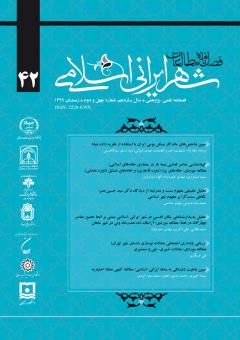تبیین ماهیت دلبستگی به محله ایرانی-اسلامی: مطالعه کیفی محله اختیاریه
محورهای موضوعی : شهرسازی اسلامیسمانه خبیری 1 , محمدرضا پورجعفر 2 , محمد سعید ایزدی 3
1 - دکتری شهرسازی، دانشکده هنر و معماری، دانشگاه تربیت مدرس، تهران، ایران
2 - استاد تمام معماری و شهرسازی دانشگاه تربیت مدرس
3 - استادیار معماری، دانشکده هنر و معماری، دانشگاه بوعلی سینا، همدان، ایران
کلید واژه: دلبستگی به مکان, دلبستگی به محله, محله ایرانی-اسلامی, اختیاریه,
چکیده مقاله :
محله در شهر ایرانی-اسلامی سازنده بنیان هویتی افراد و احساس دلبستگی در ساکنان بر شمرده میشود. این درحالی است که با غلبه گفتمان مهندسی در توسعه شهرها، محله دستخوش تغییر ساختار فضایی و سازمان اجتماعی و تضعیف پیوند روانشناختی مردم-محله شده که افول مشارکت اجتماعی، تهدید هویتمحلهای و تضعیف سرمایۀ اجتماعی را در پی داشته است. با توجه به خلاءهای نظری در ابعاد ماهوی، فرایندی، رفتاری دلبستگی به محله و از آنجا که درک عمیق نسبت به ماهیت این پدیده در بستر شهرهای کشور و عوامل تاثیرگذار بر آن گامی راهبردی در برنامهریزی محلهمحور است، هدف این مقاله مطالعه عمیق تجربه زیسته ساکنان محله اختیاریه به منظور بازشناسی ماهیت روانشناختی این پیوند و مولفههای موثر بر آن در محلهای است که بر اساس پیمایش شهرداری تهران (1396) سطح بالایی از تعلق ساکنان و پایداری نسبی سکونت را دارد. بنابراین با اتخاذ راهبرد کیفی و روش تحقیق نظریه دادهبنیاد و بهکارگیری تکنیک نمونهگیری هدفمند و نظری، 24 نفر از ساکنان اختیاریه بهعنوان مشارکتکنندگان تحقیق در فرایند گردآوری اطلاعات از طریق ترکیبی از ابزارهای مصاحبه عمیق، پرسشنامه، نقشه شناختی و مطالعات اسنادی انتخاب و تحلیل دادهها به صورت همزمان، غیرخطی، تکوینی و با تکنیک کدگذاری باز، محوری و انتخابی انجام شد. نتایج و یافتههای پژوهش نشان داد که دلبستگی به محله همچون امتداد حس خانه در مقیاس محله در ابعاد احساسی، شناختی-ادارکی و رفتاری تجربه میشود. بعد احساسی این پیوند با غرور، رفاه روانی، اندوه دوری از محله، تعلق و عضویت و بعد شناختی-ادراکی دلبستگی با رسش و پختگی پیوند عاطفی، شکلگیری خود اجتماعی، دگردیسی در نظام معنایی مکان و از آن خود کردن مکان ادراک میشود. دلبستگی با الگوهای رفتاریِ جوارجویی انطباقپذیر، پیوندجویی، عمل جمعی و مشابهتجویی بازنمایی میشود. همچنین دلبستگی به خانه، خودتعیینگری، هویت مکان، دلپذیری بصری-شنیداری، منزلت مکان، مکان-رویدادهای پیونددهنده، کیفیت پاسخگویی و ثبات، عوامل سازنده و تقویتکننده دلبستگی به اختیاریه شناسایی گردید.
Neighborhood in the Iranian cities plays a critical role in the construction of personal and collective identity, place attachment and place belonging. Such neighborhoods during the rapid urbanization and modern urban planning ideas have undergone changes in the spatial structure and social organization over the past several decades leading to disruptions in peoples’ psychological bonds with their neighborhoods and accordingly decline in social participation, social capital and local identities. According to a survey conducted by the Tehran Municipality (2017), Ekhtiarieh is one of the top ten neighborhoods in Tehran, where a high level of neighborhood attachment and relatively high residential stability have been recorded. This article seeks to identify the psychological nature of this bond by studying the lived experience of the residents of Ekhtiarieh and to identify the components that affect the construction of the attachment to the neighborhood. Therefore, the qualitative inquiry and the grounded theory methodology adopted. Using purposeful and theoretical sampling techniques, 24 residents were selected as participants in the research through the process of the data collection and analysis. In-depth interview, open questionnaire and cognitive mapping have been used for data collection and data analysis was performed simultaneously using open, axial and selective coding.Findings show that attachment to the neighborhood is experienced as the sense of home on the neighborhood level and has emotional, perceptual-cognitive and behavioral dimensions. Participants with high level of neighborhood attachment experience an array of emotions namely pride, psychological well-being and sense of belonging and membership. Attachment to the neighborhood is also experienced through maturity of person-place bond, formation of the social self, transformation in the place meanings, territoriality, and the psychological ownership of neighborhood. Analyses of lived experience of Residents shows neighborhood attachment is associated with the specific behaviors namely adaptive proximity seeking patterns, collective action, seeking similarity and affiliation. Attachment to the home, self-continuity, place identity, visual-auditory pleasantness, neighborhood status, places and events connecting people, perceived responsiveness of neighborhood, and place and community stability are factors promoting attachment to the neighborhood.
